A valve amplifier or tube amplifier is a type of electronic amplifier that uses vacuum tubes to increase the amplitude or power of a signal. In audio applications, valves continue to be highly desired by most professional users, particularly in recording studios’ equipment and guitar amplifiers. Among stereo enthusiasts, there is a subgroup of audio buffs who advocate the use of tube amplifiers for home listening; they argue that tube amplifiers produce a “warmer” or more “natural” valve sound. Tube sound (or valve sound) is the characteristic sound associated with a vacuum tube-based audio amplifier.
Before the rise of the transistor in the 1950s, all amps used vacuum tubes. Still the audible significance of tube amplification on audio signals is a subject of continuing debate among audio enthusiasts. Audiophiles disagree on the relative merits of tube vs solid state amplification. Tube amplifiers have retained a loyal following amongst some audiophiles and musicians. Some musiciansprefer the distortion characteristics of tubes over transistors for electric guitar, bass, and other instrument amplifiers.
Today tubes are the incandescent light bulb of the audio world: an older, relatively inefficient technology that consumes a good deal of energy to output a modest amount of power. For power amplifiers solid state designs can be manufactured without output transformers and are therefore immune to speaker-dependent impedance mismatches and transforer effects. I have been long the person who has usef transistors for hifi applications and considered they to be better for hifi amplifiers.
Tubes have their place in audio processing where you want to add to the sound the “warm tube distortion” sound (for example in guitar amplifiers). For preamplifer use tubes can work well. To get the idea of tube sound and how tube preamps works, I got this cheap kit for experimenting: AC12V/1A Stereo 2.0 Pre Amplifier Headphone Module Amplifier Buffer Board. It is a preamplifer that is suitable for conntrolling volume of line level audio signals (attenuate or amplify) and maybe add some magic tube sound to audio. Cheap way though of experiencing ‘tube sound’!
Type: FE-6J1-2.0B
Channel type: 2.0/ stereo
Power input: AC12V 1A / 5.5*2.5 plug
Knob function: Power switch / volume control
Size: 76 x 74 x 20mm
Pre-amp tube diameter: 18mm
Everything was packed to a plastic bags.
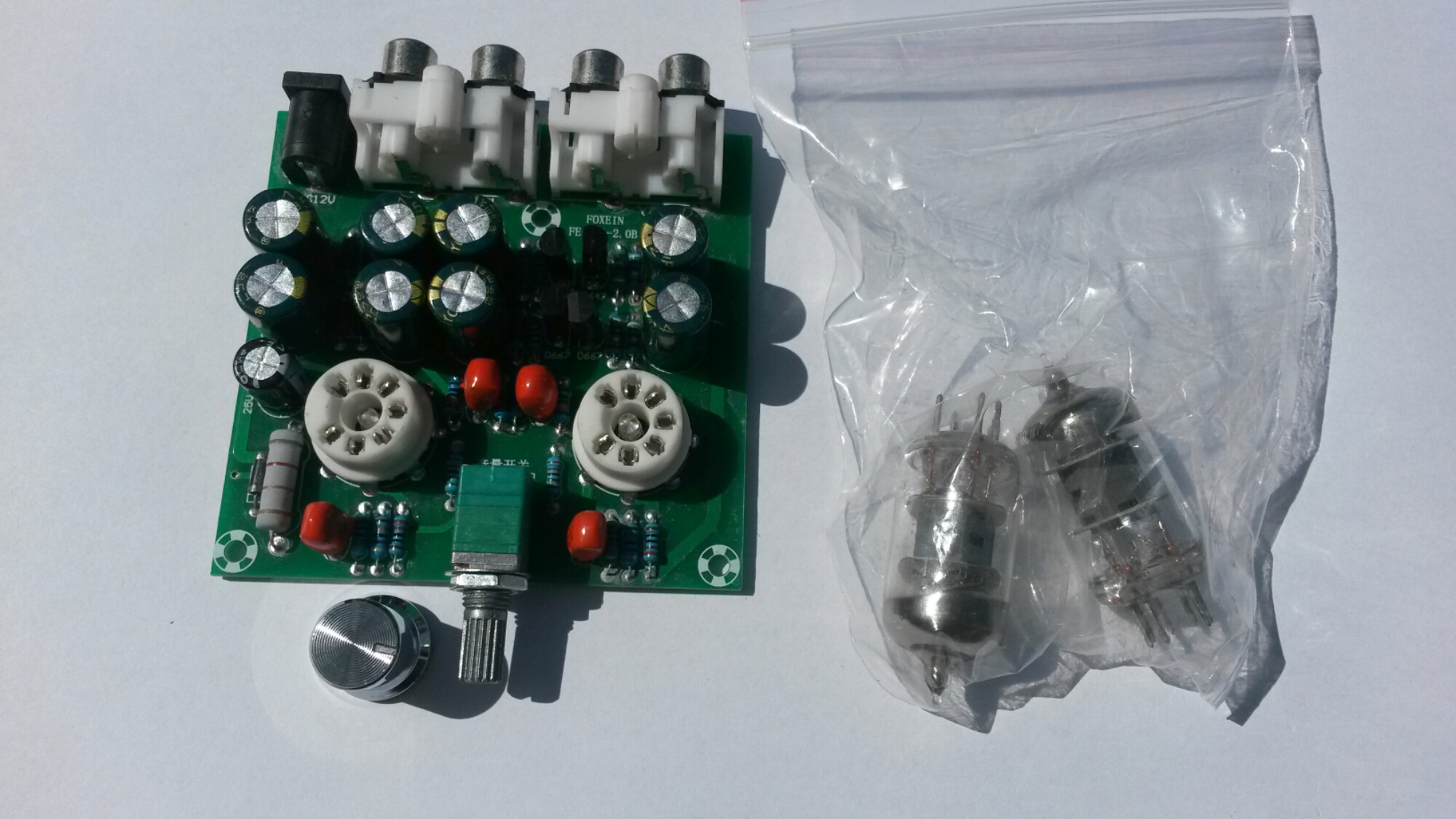
There seem to be some small LEDs in the center of tube sockers. Those are blue LEDs that make the tubes to glow in blue color.
One tube installed.
The volume control in this board is combined volume control and power switch: The knob rotates counterclockwise to reduce the volume, when the volume to the hour, continues to rotate, until the “tick” sound, then power off, lights out.
A look to the connectors…
On the left side: Audio signal input terminals that can be connected to mobile phones, computers, MP3, MP4, and other music player.
On the right side: The output terminal of the audio signal can be connected to an audio signal input terminal of a power amplifier and a power amplifier board. And next to them power input (12V AC 1A).
When I powered the amplifier, it did what it promised. It worked OK as a preamplifier.
Voltage amplification can be controlled from zero to around 6 times (around 15 dB).
The output worked on testing well to over 2Vpp input signal amplitudes at maximum amplitude without noticeable distortion on oscilloscope screen starting to appear.
The signal output impedance is around 3 kilo-ohms. That works well as line level signal preamplifier that drives power amplifier. This circuit is not headphone amplifier that drives headphones (if you thing if that from product name), it would would be pretty non-ideal headphone amplifier for low impedance headphones.
Does what it describes as preamplifier for audio signals. It sounds good, but I can’t find it to be adding any magic “tube sound” to the audio. The circuit adds some slight huming though (at more than about 1/3rd volume).
Note on powering: you need an (not DC) 12V plugpack or transformer. The kit says it needs 12V 1A power supply, so that what I used (I did not measure the actual power this circuit takes).
Ti get better idea how this circuit amplifier works, a circuit diagram would be nice. With some Googling I found that there are several pages that tell about this or very similar tube amplifiers:
https://www.circuitlab.com/circuit/9vnehk/fever-6j1-tube-pre-amp-circuit/
http://www.diyaudio.com/forums/tubes-valves/286349-6j1-tube-buffer-circuit-diagram.html
The best circuit diagram I could found was this at https://www.circuitlab.com/circuit/9vnehk/fever-6j1-tube-pre-amp-circuit/
It seems to be mostly correct (shows only one channel), but has some small details that do not seem to be correct (for example connection of resistor on amplifier output should be connected to ground and not -28V). By the way the circuit diagram can be edited at https://www.circuitlab.com/editor/#?id=9vnehk
As you can see in the circuit diagram the power supply part converts the 12V AC input to +28V and -28V power rails that are used to power the tube. This means that the tube is run at 56V voltage (which is quite low voltage for an audio tube circuit, they typically operate at 100-300V voltage depending on tube type). This 56V voltage is good for safety – it does not hurt too much if you accidentally come in contact with this voltage when you test the board before putting it to case.
The power supply circuit consists of voltage multiplier + rectifier circuit followed with filter capacitors, some transistor circuitry (emitter follower with current limiting, somewhat resembles gyrator circuit) and more filter capacitors.
The tube heaters are directly powered from input 12V AC (two 6.3V heating coils in series can be powered from 12V AC).
Information on the 6J1 tube used can be found at http://www.radiomuseum.org/tubes/tube_6j1.html and http://greatsound168.pixnet.net/blog/post/254453398-%E4%BA%8C%E5%8F%B06j1%E7%B7%A9%E8%A1%9D%E7%B4%9A%E7%9A%84%E5%88%86%E6%9E%90
Another preamp circuit using 6J1 tube at http://www.yunwt.net/1mydiy/qt14.htm
The basic design of this AC12V/1A Stereo 2.0 Pre Amplifier Headphone Module Amplifier Buffer Board seems to be sensible. If I had designd this I would maybe had designed few things slightly differently (for example power supply filtering and maybe tube heating) – that could have maybe reduced the slight mains humming on the output. Anyways as it isC12V/1A Stereo 2.0 Pre Amplifier Headphone Module Amplifier Buffer Board seems to be good quality cheap tube preamplifier.
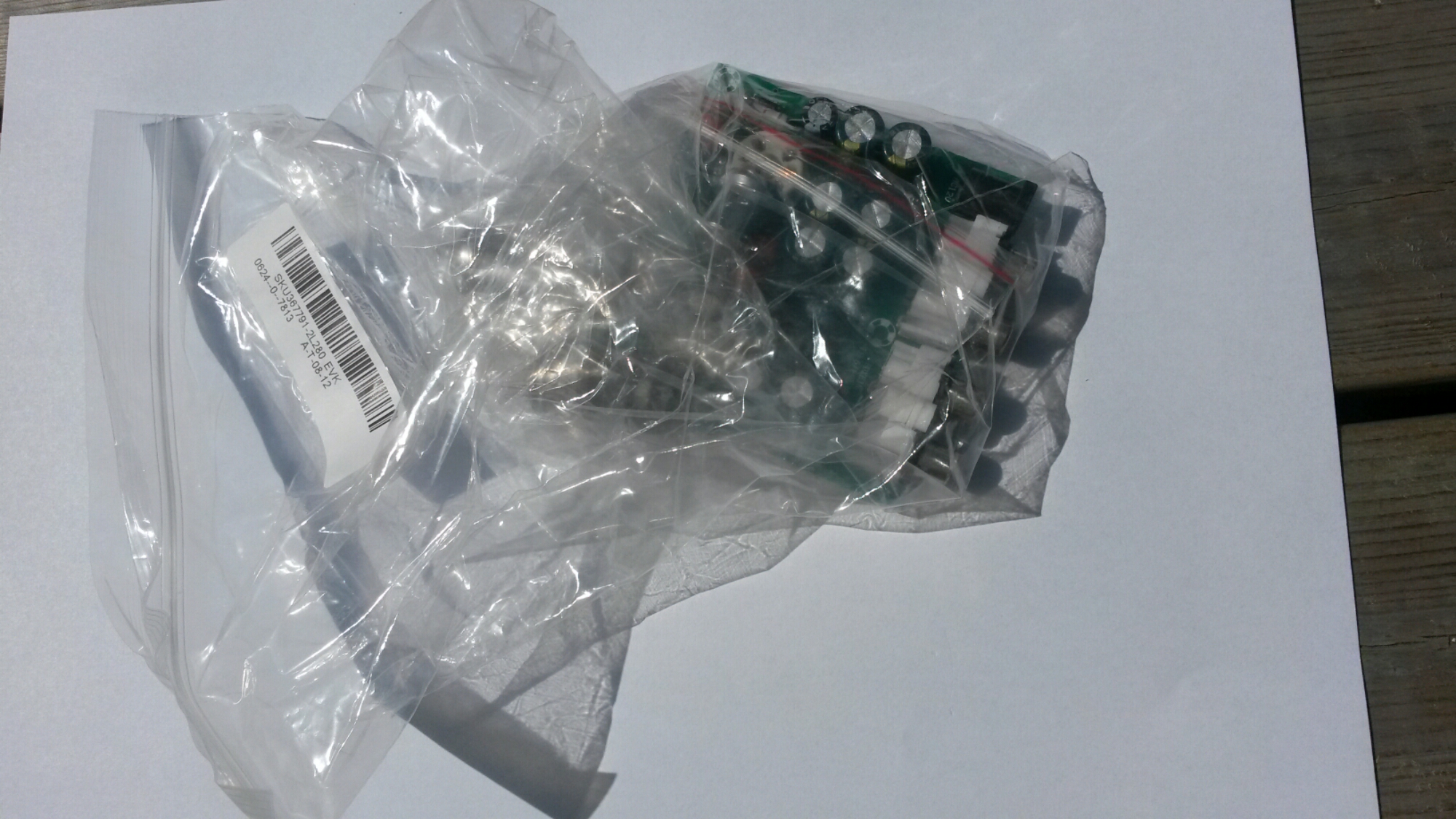
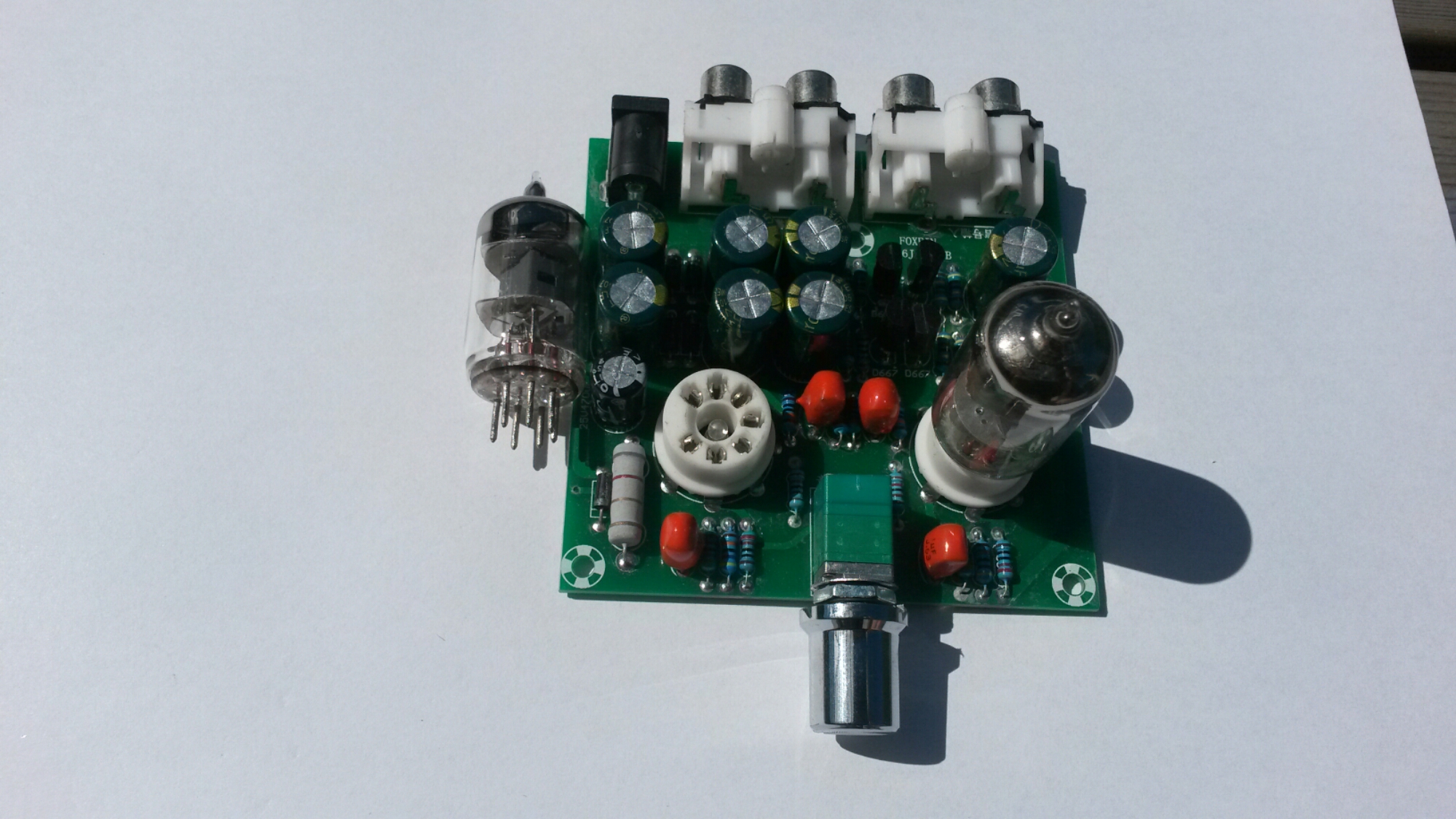
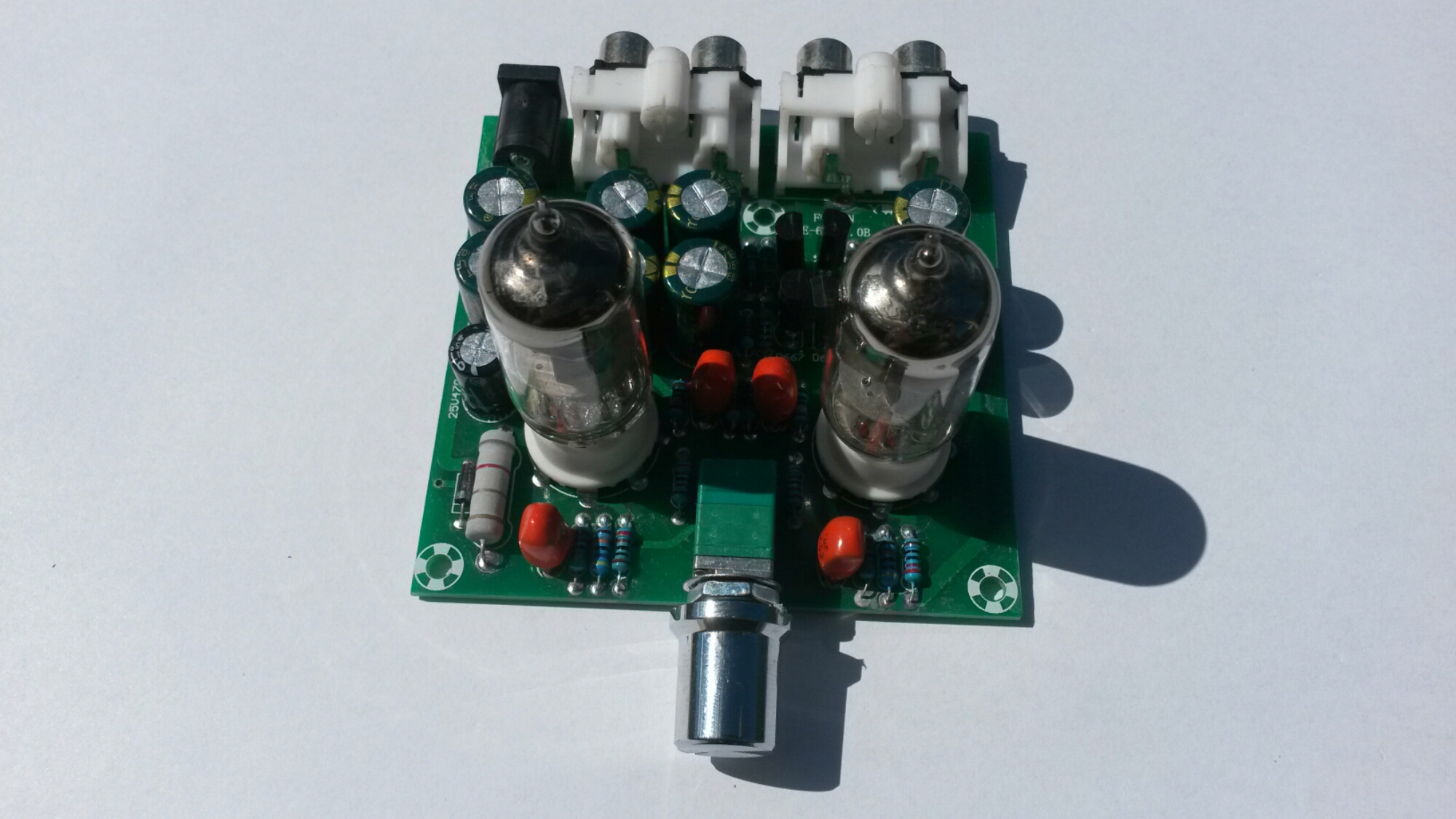
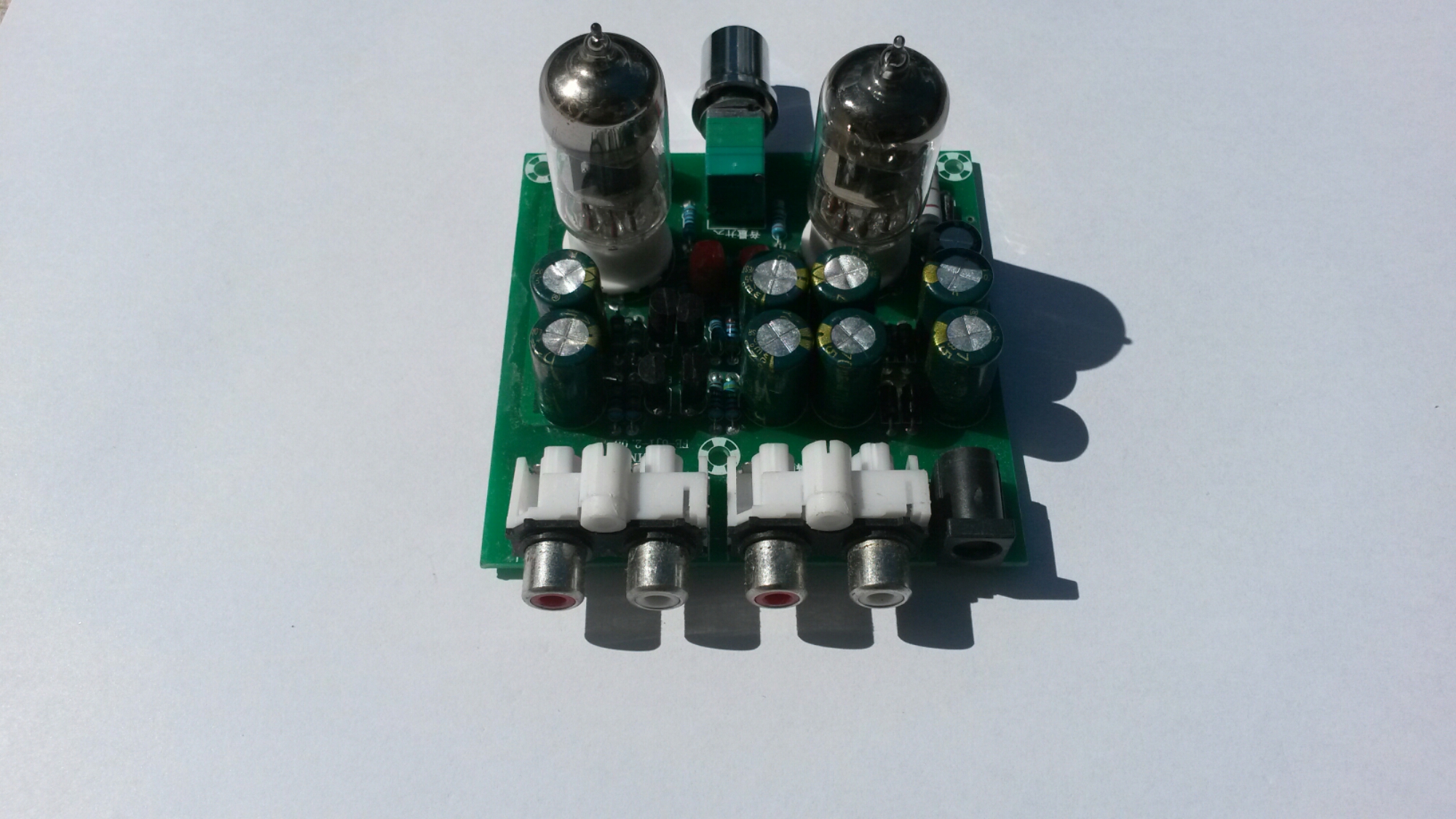
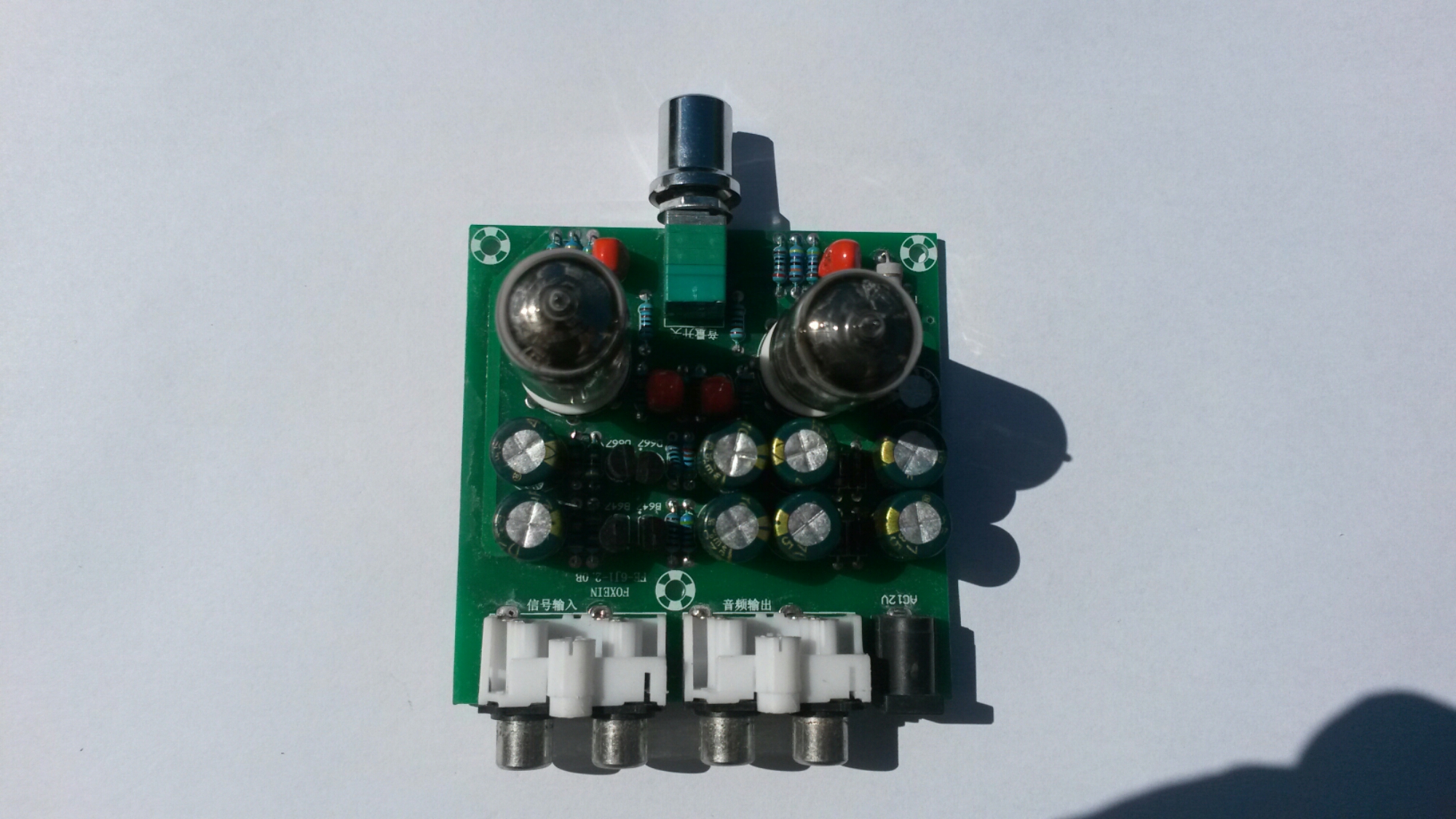
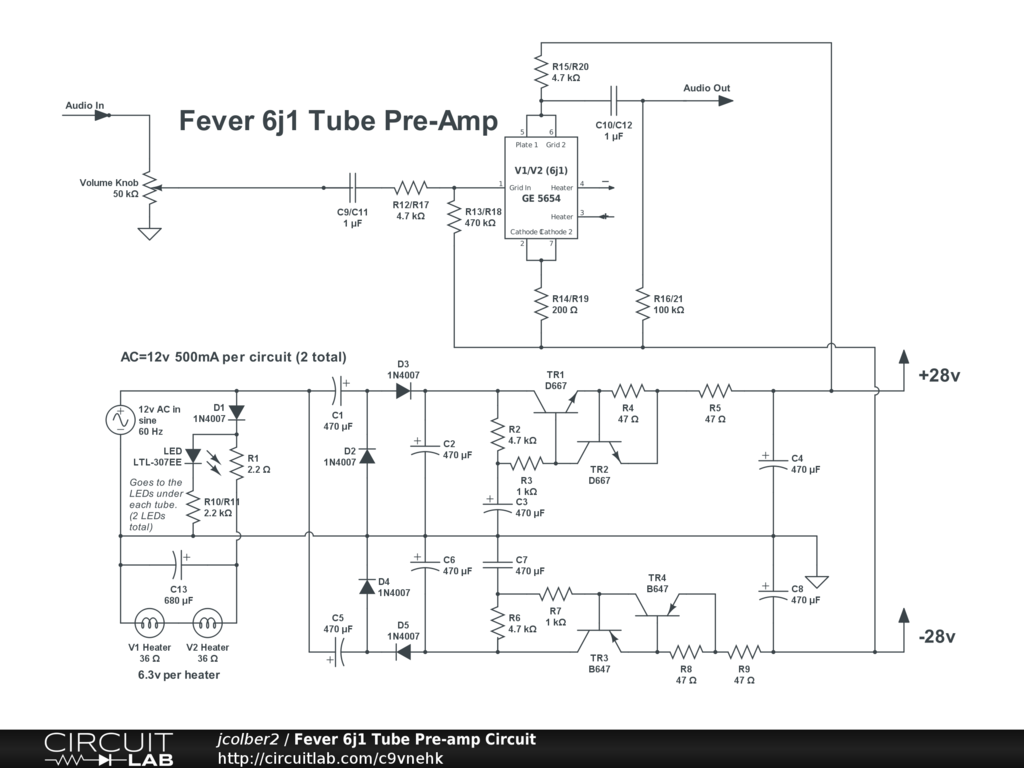
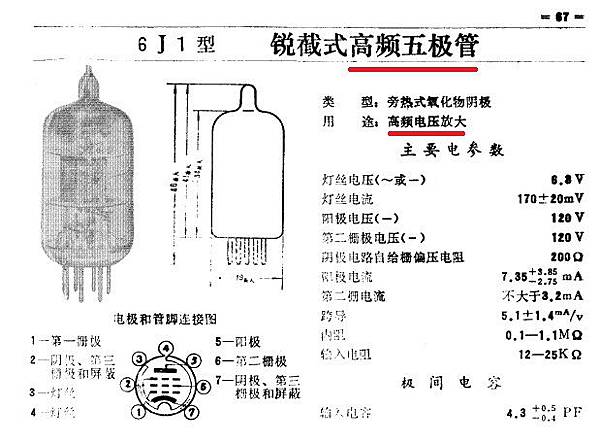
276 Comments
Tomi Engdahl says:
harmonic distortion adds frequencies that didn’t exist in the original sound.
Tomi Engdahl says:
https://www.nti-audio.com/en/support/know-how/lets-clear-up-some-things-about-distortion
Tomi Engdahl says:
Of course many “audiophile” tube amps are run single-ended class-A, so some of them have horrific linearity. So much so that they will become the dominant source of harmonic and intermodulation distortion in your system. An example: https://www.decware.com/newsite/SE84UFO-MANUAL.pdf lists 2%+ THD figures, which is not great unless you like the way that sounds. If not, either get a push-pull type from a reputable manufacturer like McIntosh or similar, or just use a conventional linear or class-D based solid state amp for low distortion.
Source: https://www.youtube.com/watch?v=j2vPU4ShL-c
Tomi Engdahl says:
https://www.mojotone.com/blog/tube-distortion-your-amps-dirty-little-secret
Tomi Engdahl says:
What’s More Important? Tube Preamp or Power Amp? Too Many Tubes? w/ Upscale Audio’s Kevin Deal
https://www.youtube.com/watch?v=j0gWmV-vilU
Skip the B.S. Where do you REALLY get the glory of tubes? Amp or pre? And really…can you have too many tubes?
Tomi Engdahl says:
Why I Can’t Tell You Which Tubes To Buy, and some helpful TIPS! w/ Upscale Audio’s Kevin Deal
https://www.youtube.com/watch?v=Zn1ldpDWYfw
Kevin kills off a couple commonly held myths and bullsh*t about tubes. He wants you to know he loves you like a brother (or sister) but has to work hard to get you the COOL STUFF. Tube calls with Kevin sadly are not possible. Use this video and reviews from others.
He also doesn’t want Upscale employees to say how a tube “sounds” because they don’t know. They haven’t tried all the tubes, so to act like they have to just sell a tube is dishonest and goes against what Kevin says in every video:
“We treat your system like it’s ours”
Tomi Engdahl says:
GE 12AU7/6189W Vacuum Tube Review w/ Upscale Audio’s Kevin Deal
https://www.youtube.com/watch?v=Jr1SF1aJWNg
Helically-wound filaments baby! Kevin recently found a stash of these, and soon as we’d tested a big enough batch to give us the tightest possible matches, these NOS tubes went out into the world and sent back rave reviews.
Robert H. Levi wrote in Positive Feedback: “In addition to excellent definition, the GE 6189 tubes were the quietest 12AU7 types in the world. … With the quiet came added definition, layering, blacker background, and greater realism.”
Viewer comments:
Been buying tubes for the past 25 years and have never been disappointed with tubes from either Upscale or Jim McShane. I’ve pretty much given up on every place else.
Tomi Engdahl says:
Apex Tube Matching- Behind the Scenes!
https://www.youtube.com/watch?v=0-WWAc1bwRs
In this video Yvonne will show you the step by step process of how Apex Tube Matching matches vacuum tubes with the most precise system in the industry!
https://www.apexmatching.com/
Viewer comments:
Absolutely fantastic to watch! I now have an even better insight and direction to go when I purchase these tubes. I have been using these tubes for many years, but now I have a renewed confidence what I am purchasing for my customers is of such great quality. Thank you, Yvonne for your video on these!!
Cool video! Thanks for posting. I’ve been curious about this since buying my first tube amp. I watched this a couple hours ago and came back, I keep thinking about Irvin unpacking alllll those tubes! haha! My respect.
haha! My respect.
Tomi Engdahl says:
Vacuum Tube Myths and Snake Oil Bull**** Debunking
https://www.youtube.com/watch?v=ZyqJp_anLeg
BG214 – In this episode of Soapbox Sunday we debunk or at least give our opinion on several common tube snake oil myths. We debunk the fact that you have to buy vintage tubes to get good sound, that tubes require burn in, that cryo treatment of your tubes works, and that tube dampers help.
Tomi Engdahl says:
Are vacuum tubes worth it?
https://www.youtube.com/watch?v=s74zqjfywxM
Vacuum tubes are the original amplification devices. How do they stack up against modern solid-state transistors, especially in audio systems?
Where in the system are vacuum tubes best appreciated?
https://www.youtube.com/watch?v=TJR8tEYORzg
Have you ever heard of a tube buffer? What are they, and when should they be used? Are they BS or real? And, for that matter, where should we place and use a vacuum tube when designing electronics?
Tomi Engdahl says:
How long do tubes last?
https://www.youtube.com/watch?v=P1oBZ4XxDk4
Vacuum tubes are a critical element in many high-end audio products. How do we know when to change them?
Tomi Engdahl says:
Why do tubes sound different than transistors?
https://www.youtube.com/watch?v=_bqDAvhm_RU
Most recognize the difference in sound quality between tubes and transistors, but why? They both amplify, they both make music, can be used in any electronic circuit, yet perform differently. Paul does his best to explain the inner workings of tubes and differences with transistors.
Tomi Engdahl says:
Solid State amps verses Valve amps
http://education.lenardaudio.com/en/12_amps_8.html
This page consists of an explanation of Voltage-drive and Current-drive, which enables us understand why Solid-state and Valve amps sound different. When solid-state amps were introduced there was little interest taken in how amplifiers and speakers interact. Manufacturers of amplifiers and speakers have little in common. It serves the interest of marketing to separate speaker systems and amplifiers into different categories and brand names enabling retailers to have greater control in how customers are influenced and profits made. This imposed marketing separation also suits those who attain notoriety as Thiel Small loudspeaker design experts. Academic mis-application of Thiel Small parameters has resulted in a bewildering convolution of speakers designs many of which perform pooly. This is also the reason for the traditional marketing hostility against integrated active sound systems, but this is starting to change.
The complimentary page (Valve / Solid-state) in the Valve amps chapter, approaches the difference between these amps from the perspective of the physics of a valve amp, whereas this page describes the difference from a technical perspective of a solid-state amp.
Tomi Engdahl says:
RCA Tube Manufacturing In Lancaster PA (1966)
https://www.youtube.com/watch?v=FUMIPvBi8Sk
A truly one of a kind reel from my collection, this one I picked up in a second hand shop in Lancaster County back around 1993 and it is a training film made in 1966 just for a single production stage at the massive RCA Vacuum Tube Manufacturing Plant that was the major employer in Lancaster at that time. I determined the year based on the date code on the Kodak film stock, and this reel was transferred from my own 16mm archive print using my Eiki Telecine. The Eiki projects a 24fps print at 30 frames per second for a flickerless NTSC transfer. A special diffusion plate eliminates the ‘hot spot’ of the projector, and the sound is pulled right from the optical track. Enjoy!
Viewer comments:
This factory is still standing
It’s used as warehouse now, the nearby car dealership uses their parking for overflow. I
Fascinating footage. Like Elon Musk rightly points out, it’s not the invention or designing that’s hard, it’s the production system. Actually, they are all hard, but the doing the production takes vastly more effort than the twi others.
It’s surprising how much of this line involves manual operations as late as 1966. No safety glasses, almost no fume and dust extraction – it really looks like a cottage industry, yet is was RCA.
Tomi Engdahl says:
Six Common Mistakes Made When Recapping Vintage Electronics
https://www.youtube.com/watch?v=BeDKwi-GJRI
Short little video on common mistakes seen when recapping (replacing capacitors) vintage electronics. This would include vintage stereos, radios, equipment, CBs, ham radio receivers & transmitters, calculators, computers, you name it.
Hopefully this will provide you some tips and hints to use when you go to recap your piece of vintage gear.
Topics include:
- Mistaking Factory Glue for Leaking Capacitors
- Factory Boards and Manuals Marked Wrong
- Capacitors Installed Incorrectly
- Using Larger Capacitors Than Specified
- Buying Electrolytic Capacitors off Ebay
- Replacing Everything at Once
Viewer comments:
Great video with lots of good points. I would caution about using a replacement electrolitic capacitors
with with a voltage a lot higher then the original. Such as putting a 350 volt in place of a 25 volt because it won’t stay properly formed with the lower working voltage.
While it is not in the scope of this video, all that glue on those circuit boards, that some over time degrades and becomes caustic and conductive. As long as you are replacing the capacitors, you should remove the glue as well. Once again this is a great video, keep them coming when you can, stay safe and have a wonderful holidays.
A possible exception to your suggestion against “shotgun” recapping is when restoring very old equipment. 50 or 60 year old electrolytics are often shorted, or nearly so. Turning on the equipment with such caps in the power supply can cause serious damage. The same applies to interstage coupling caps in tube amplifiers. If those are electrically leaky, B+ will flow to the grid of the next stage and that is also damaging.
I’d add two more tips for vintage radios and audio gear: 1) check for the shielded end of non-polar caps and tie that to the lower impedance side of the circuit, and 2) check for effective parallel resistance (leakage) which can change tube/transistor bias dramatically, causing the unit to work poorly, not at all, or burn up tubes or transistors.
Repairing Vintage Audio Equipment. Solid State & Tube. How To Repair & Restore Old 2 Channel Stereos
https://www.youtube.com/watch?v=E3yTtm3yCG8
I will guide you through the entire process of repairing and restoring vintage audio equipment. You will learn what it takes to repair and restore vintage stereo equipment. Many year’s of vintage audio repairing, restoring and collecting experience is put into one fast moving 30 minute video. Enjoy!
I will show you the following -
1. How to repair and restore your vintage stereo equipment.
2. How to find parts for your old stereo equipment.
3. The hand tools needed to fix your 2 channel audio equipment.
4. The test bench equipment that you need to repair and restore old audio equipment.
5. Troubleshooting tips for receivers, amplifiers, tape decks and more.
6. Why you should replace certain components in your vintage stereo gear.
Tomi Engdahl says:
How to Measure Tube Amplifier Plate Current (Biasing) and Actually Understand What You Did
https://www.youtube.com/watch?v=a_HJKlRLbhM
BG280 – How to measure the Plate (Anode) Current in most vacuum tube amplifiers and actually understanding what you just did. This theory should work for Audio Hi-Fi amplifiers as well as most RF amplifiers.
Tomi Engdahl says:
Reviewing a cheap 6J1 tube preamp.
https://www.youtube.com/watch?v=ldKf7goMQ1I
6J1 tube preamp.
Tomi Engdahl says:
6J1 CHINA TUBE PRE-AMP LM1875T 20W +20W DIY
https://www.youtube.com/watch?v=YbuyRZsp7sw
6J1 CHINA TUBE PRE-AMP CIRCUIT MODULE
https://www.youtube.com/watch?v=fDplmDzySvQ
Tomi Engdahl says:
From
https://www.facebook.com/groups/DIYAudio/permalink/4805164712882670/
Hi, I was wondering if this article from an old Electronics magazine from the UK would be of interest, it’s about combining a transistor pre amp with a valve power amp without the need for an extra power supply. see the full article, together with the magazine it’s from here: https://worldradiohistory.com/UK/Everyday-Electronics/70s/Everyday-Electronics-1978-11.pdf
then scroll to page 826.
Tomi Engdahl says:
Hand Made Vacuum Tubes by Claude Paillard
https://m.youtube.com/watch?v=EzyXMEpq4qw
This wonderful video shows Claude Paillard, a French radio amateur (F2FO), making his own vacuum tubes (or thermionic valves). Just sit back and watch this delightful images.
You can find out more and get the original video file here:
http://paillard.claude.free.fr/
Tomi Engdahl says:
Tube output transformers
https://www.facebook.com/groups/VTAgroup/permalink/10157998818961333/
depends what you want. It will work, but Ive never been that impressed with Hammond, even their hifi series. But they are cheap. If you want cheap you get cheap. If you want to spend a bit more you will get much better performance IMO. Edcor are well known in the US, alternately Electra Print will custom make something for you for a decent price. Other options I would consider – Silk Audio in Thailand seem to make a good product although Ive never tested. There are a couple of people on here that make transformers to order also. Ive never tried Raphaelite transformers but they seem worth a go, also James are highly regarded but now hard to find. Some of those could be worth considering depending what you want to spend
Lundahl hi fi transformers.
My first thought, but the headphone OPT had a really low input impedance for a 12AT7. 5kohm is out of spec for the tube.
Tomi Engdahl says:
Triode Vacuum Tube: History & Physics
https://m.youtube.com/watch?v=0Smj2nHo9zA
How does a vacuum triode work and why was it invented? This is the story of a smudge in a light bulb, an assistant with a good memory and a con artist working around a patent and one of the most important wires in history! Check it out.
Tomi Engdahl says:
AT&T Archives: A Modern Aladdin’s Lamp, about vacuum tubes,1940
https://m.youtube.com/watch?v=_-JzxX75oYc&t=0s
John Kershaw says:
Hi Tomi,
I’m trying to work out a mono summing circuit for this to attach to a 1920s 2k ohm speaker. You stated the preamp has a 3k ohms output impedance. Was this is a rough guess or has this been tested somewhere as I can’t find this figure anywhere else?
I’m looking at bridging the ouputs with 2k resistors, when monoed, L 3k out + R 3k out, + resistors = 10k ohms. then a 2.24 : 1 audio transformer gives me 2k ohms output to attach to the speaker. The speaker needs around 0.25 watts to power it. Would a 10k ohm load/transformer damage the pre-amp or would this be ok? I only know enough to be dangerous!
Regards
John
John Kershaw says:
The reason I’m not using a mono pre is because I’m also running stereo headphones off it. 1 pair 2k ohms, 1 pair 4k ohms, so 3k ohms output and low wattage is a perfect match. Headphone amps or power amps impedances are wayyyy off.
I will switch between stereo, and the mono summing circuit for the 2k ohm speaker
John
Tomi Engdahl says:
Tubes vs solid state
https://www.youtube.com/watch?v=ANMep0uG4lQ
Can solid state ever achieve the holographic imaging of vacuum tubes?
Viewer comments:
I’ve heard great solid state amps and great valve amps; there isn’t a yes/no answer. Combining a random solid state power amp with a random valve preamp also doesn’t guarantee a ‘better’ system. From experience there are more all-valve amps that deliver that ‘something special’ than all solid state amps. Even a quick lash up of a valve amp can have some magic, even with relatively poor performance on paper.
I tried ss, hybrid,and all tubes. I can tell you from my experience that all tube set up will definitely the way to go. But you can also achieve similar results in a hybrid setup but you will have to spend 3x to get there.
Tubes are special. I sold more expensive equipment and bought much cheaper gear with tubes and the sound was much better. I agree with Paul that having just one tube component (DAC or preamp) is best and use solid state for the power amps. The DOGE DAC7 is incredible for the money. I don’t care about holographic images though. For me, tubes are special because the music sounds more real.
The long gone company Counterpoint used to do tube-SS hybrids. I still have one of their pre-amps. It was a sort-of-neat idea back then (in the 1980′s), but I’ve come to think that the tubes are simply a preferred euphonic path (probably due to even harmonics) for some who want to avoid the edgy reality that surrounds us.
have a BHK Pre and 250 amp, and the PS Audio hybrid amps are definitely holographic. Moreso when I put NOS tubes in them. Maybe not quite to the degree as full tubes, though. For pure solid state Pass, Ayre, Luxman and Bakoon are all pretty good in that respect.
Agree. Such a subjective topic – I’m sure there’ll be millions of comments! Bang for buck For me absolutely, hybrid configuration with a high quality tube-pre (well coupled) and a solid-state power-amp stage, winner winner chicken dinner! Great post.
The big difference I can see is that tube output stages are basically AC current-sources, meaning that, unlike with solid state, the output voltage more-or-less ‘follows’ the impedance curve of the attached speakers, altering the frequency-response..
The preamp stage is where sound colouration occurs and where the weak input voltage is boosted.
I agree with Paul on using a vacuum tube amp on the input stage and a solid state amp on the output stage.
The output stage will increase the current (or power) in order to drive the speakers properly.
Guitar amplifiers work in a similar way in that the pre amp stage is where the amp’s unique characteristics are imparted to the weak signal from the guitar pick ups.
One vacuum tube in series with an audio signal that has gone through a “ton” of op-amps and transistors from music production to speakers doesn’t make the signal path into a vacuum tube one, and the effect can only be additive. There is nothing wrong with enjoying tube sound, which can be very musical, but please don’t use the term “purist” for someone adding a tube in an otherwise already “transistorized” signal path. Tube sound can sound awesome with many genres of music giving it a more live audiophile holographic feel, and that’s what matters.
Some good recordings, dating back twenty years or more will have passed through mixing desks of the era, using hundreds of very dated op-amps by today’s standards. It’s hard to imagine how a Tube stage makes the overall sound better if not burying some of the nasties from those devices.
vacuum tube colors the sound. what you want is as much unchanged sound as possible. if you do not get good sound with a good and expensive amplifier then the problem is speakers or sound source or music recording and not the amplifier
Yes, personally I rather EQ my system for optimum neutral frequency response than add tube distortion. The former is much more “purist” than the latter, but many audiophiles got that upside-down.
There’s nothing wrong with liking tubes … but it’s definitely not the best technology to use.
I don’t use tubes but I respect those who enjoy tube sound and have experienced some music being enhanced with it. Yeah, tubes are quite terrible technically speaking with inconsistent performance over time. But if a tube makes you happy, so be it. Some people wear makeup and it’s not for me to tell them they shouldn’t.
“I replace the tubes in this system on a fairly regular basis because it just brings more life to it”
So that means that at hour one of tube usage to hour 500 the tube sounds different? I suggest that’s a universal yes. Does it sound different hour one to hour 500. Sure I don’t think anyone would challange that. What’s changing? More, or less distortion? Can the change be measured?
Given a group of listeners 9 out of 10 will prefer the sound of tubes. The best place to put the tube(s) in your circuit is at the front end. The input stage, just like PS Audio does.
Is the sound of a tube amp different then a Solid State amp. Read the above
Is the sound more accurate in a Solid State amp. Read the above.
Most listeners will prefer the tube sound as against the “dry” and “lifeless” Solid State amp.
Which amp is delivering the content more accurately? Read the above.
My SET amp has more bass, than ANY solid state amp, I’ve owned… That really surprised me, because I heard so many say SET amp lacks bass/bottom end..
Yes, but what is the quality of the bass? Solid state tends to be cleaner, tighter and can dig deeper. What is your tube amp?
An old 300b chinaman.. Lot’s of heavy iron.. Yarland pro 200SE(old version).. Slightly modified- I have very difficult, demanding speakers- Horning Alkibiades, with Lowther DX4′s and two backfiring 12″ woofers.. No other amp has been able to do what this amp does.. I used to bi amp before, because to bass needed more power.. Not anymore. Never thought, I could go with only one amp.. I get goosebumps, everytime I listen to music.. Always avoided SET amps – didn’t believe the hype. I get it now.
A vacuum tube and a transistor are both devices that control the flow of power from the input to the output. There is no particular magic in either one. That being said, I do think the physical size of the tube makes it easier to transfer those electrons. What tubes do however, is force simplicity on circuit designers. When was the last time you saw an amp with 16 output tubes? It happens with transistors. I built a single ended triode amp about 25 years ago. It has 24 parts per channel, from the input jacks to the binding posts. It was, and continues to be, the best sounding amp I have ever heard, and it changed the way I think about audio forever. I also built an Amp Camp Amp designed by Nelson Pass. It is a transistor single ended amp. It shares many of the S.E.T. traits while falling short on the lifelike qualities the triode tube can produce. I was using Audio Research Classic 150 amps when I built my S.E.T.–mono, top of the line when I bought them, triode wired tetrode tubes, Class AB, and, yes, 16 total output tubes. I sold them shortly after building my S.E.T. It’s not the tubes, it’s the topology.
As hifi is always very personal and subjective thing – .in regards to what sound characteristics we like or want to hear…I can only say I love the hybrid route myself …especially for digital music, streaming and playback. As tube pre amps or having tube in the input stage can definitely bring a little more harmonic warmth and dimensionality to the sound.
9 out of 10 audiophiles will prefer the sound of tubes. Is it more accurate?
hmmm…truth is, with so many (pre recording, post production and equipment) variables involved…. I think music capture and reproduction is all a compromise of sorts. As no recording or hifi system is truly accurate or respresentative, but are however people and companies best (or worst) technical approximations!
So personally I think it simply comes down to pleasing our personal hearing, preferences and tastes…and budgets
As I have stated 9 out of 10 listeners will prefer the sound that tube amplification produces. Did you notice that all during this video Paul used “Holographic” many times but never once “accurate”. Sounds good sells. Dry, detailed, flat, unforgiving are never brought up.
I am a long time fan of Nelson Pass and have owned a number of his products. I still have one of his preamps. It’s like a wire with gain. But it’s dry, flat and unforgiving. And definitely not holographic. Unless of course the content is.
Holographic sound has nothing to do with the choice of amplifier technology and to suggest there are only a few “amps” that can produce holographic sound is complete and utter BS
Correct.
Depends on your listening tastes and ability to discriminate music. I’m listening any kind of music. If you try to listen punk and metal guitars in tubes the result in comparison with a very good solid state is awfull.. But you may say.. “i dont care.. dont like this kind of music”.. ok then try to listen a classic, like this https://www.youtube.com/watch?v=l4zkc7KEvYM and try to listen clearly the piano with.. and without tubes. You may disagree.. but i find that tubes smooth the sound against instruments discrimination.
So, if human hearing is sensitive to natural binaural spatial cues Interaural Level Difference (ILD) and Interaural Time Difference (ITD) created by ear orientation, outer ear pinnae shape, head shadow, and the distance between the ears, and stereophonic imaging is a property of the recording created by artificial stereo channel level and time differences created by microphone directionality, microphone orientation, microphone spacing, and mixing console panpot controls, and stereo channel level and time differences are rendered by spaced directional speakers, and separate amplifier channels provide essentially identical and independent signal paths, by what magic does an amplifier create holographic imaging?
It’s all smoke and mirrors.
Exactly!
Its not the tubes that makes the sound its transformers.. It adds lots of harmonics,, thats why sound get befier and smother (cuts high end with smoth unlinear slope), tubes only make distortion difrences, but when playn loudly next to speaker it vibrate itself so it makes un even microphonics (glass itself).. Thats why guitarist like them and dont know why lol.. Thats the whole secret
Solid state on the output ( IMHO) is the way to get the bass slam present in certain music.
tubes are fun because you can change the sound to your preference by changing the tubes if the amp is compatible.
Let´s talk serious guys. It all depends on your bank account. Joke. If my music would be 99% Jazz, classic etc. of course Tube Amp would be the way to go. If you hear more POP, Electronic etc. than i would go for Hybrid or solid state. It´s that easy.
Tomi Engdahl says:
Mike Matthews owner of Electro Harmonix says no more Russian vacuum tubes in 2022
Are vacuum tubes about to become more scarce?
https://www.gearnews.com/mike-matthews-owner-of-electro-harmonix-says-no-more-russian-vacuum-tubes-in-2022/
Due in part to the Russian invasion of Ukraine, it looks like there could well be a worldwide shortage of vacuum tubes/valves. This would affect anyone looking to buy or use valve based music equipment.
Brands now affected by the export ban
Since the EHX family of tube brands includes: Tung-Sol, Electro-Harmonix, EH Gold, Genalex Gold Lion, Mullard, Svetlana and Sovtek, this could a bad year for manufacturers looking to build valve amps, and valve-based effects.
Russian Factory
Electro Harmonix bought a Russian factory that manufactured vacuum tubes in 1998 and since that date, it has had a relatively steady supply of tubes, with the odd bump in the road here and there.
Tomi Engdahl says:
Distortion will never be the same again
Tomi Engdahl says:
What companies still make vacuum tubes?
Tube Brands
Electro-Harmonix.
Genalex – Gold Lion.
JAN Military.
JJ Electronics.
Mullard.
Northern Electric.
Preferred Series.
Russian Tubes.
Tomi Engdahl says:
https://www.rfcafe.com/miscellany/homepage-archive/2013/does-anyone-still-make-vacuum-tubes.htm
Tomi Engdahl says:
https://brimaruk.com/menugbvp/great-british-valve-project-2/
The UK was the centre of thermionic valve (tubes for our U.S buddies) production for many years and we produced the best and most consistent products which are still highly sought after even now – nearly 50 years after production stopped. Our dream is to restart manufacturing of valves in the UK using existing knowledge and equipment but bringing it into the 21st century where not only consistency and performance are drivers but efficiency and the environment.The Great British Valve Project is about creating a valve manufacturing base in the UK. There have been many twists and turns since we started this project back in 2015 but our biggest break throughs have been finding a backer and the final acquisition of equipment which will allow us to start small scale manufacturing of a limited range of valves in the UK.
Tomi Engdahl says:
Electro-Harmonix Discontinues New Tube Sales
https://lm.facebook.com/l.php?u=https%3A%2F%2Fwww.premierguitar.com%2Fnews%2Felectro-harmonix-discontinues-new-tube-sales&h=AT2P_kPOsvVAs-wwkOM7v58AgJYfxL9RqaiSOS0BTl41H8As0ZiEJLZTtRW6ihAD9nikkUd9hniJYvslx8hSzvrLT3-7eQa72-zPYaNETjes2x2PIp7IM2mOCNOUQEkrOpF32gZbshxjHNc6Ew
In a message posted to its website, Electro-Harmonix has stopped taking any new orders and fulfilling back orders on all Russian vacuum tubes. This is due to a ban that Russia has imposed on over 200 types of goods.
https://shop.ehx.com/russian-tubes/
ATTENTION ALL EHX TUBE CUSTOMERS
The export restriction on Russian tubes has been resolved for now. We are accepting new orders, processing backorders, and hoping to resume shipping in April. Priority will be given to the oldest orders.
Tomi Engdahl says:
Taitaa kohta viimeiset tehtaat olla slovakialainen JJ Electronics: https://www.jj-electronic.com/en/ ja kiinalainen Hengyang Electronics: http://www.psvane.com/en/hifiseries.html
Tomi Engdahl says:
Monen asiantuntijan mielestä tämä on ollut paras ja kestävin uuden tuotannon ECC83 tyyppinen lamppu ja nyt markkinointifirman sivulla on myös uutta tietoa venäläisvalmisteisten putkien saatavuudesta (Kukin tietenkin tekee tässä maailmantilanteessa kuten itse parhaakseen näkee, eli ostaako näitä tuotteita enää vai ei): https://shop.ehx.com/item/12ax7%20tungsol/tubes-vacuum-tung-sol/
Tomi Engdahl says:
All of us should go to this link and fill out the form on what tubes Western Electric should add to their line up. They’re alread making tubes in America and have been for a few years.
We make electron tubes
https://www.westernelectric.com/expand
Western Electric is assessing plans to expand tube operations. Our latest factory is equipped to handle production of multiple tube types and, in light of recent worldwide events, we believe our capacity to do so may become vital to the industry.
While we continue to meet steady demand for the type 300B triode, we want to hear from you regarding other popular tube types. Click below. Fill the form. After you share your thoughts, be sure to share this page with others.
Western Electric has made quality tubes for over 100 years. Here’s to the next 100.
I’M INTERESTED
We use cookies to improve your web experience. By continuing to use our website you agree to our use of cookies on your device. Read more
Tomi Engdahl says:
For those out of the know, guitarists (still) like vacuum tube-based amplifiers. They are also used in a few other applications by preference (hi-fi audio) or in places like radio transmitters where nothing else can do the job.
One of the few remaining manufacturing plants in the world was in Russia – a relic of Soviet Russia’s antiquated military that still used them in much of their hardware until fairly recently. One other plant was in China, but it closed four years ago to relocate and hasn’t been seen since. There’s only one other plant, in Slovakia.
The Ukraine/Russian boycott cut off the Russian tubes from the market. Western Electric conducted a survey of guitarists to gauge interest in them manufacturing tubes. It took only a week of survey time for them to conclude it was a go. They have announced that they will be building the tubes at their site in Georgia, USA.
They’ve pledged not to gouge on the tube prices, so tube users and manufacturers are hopeful that this works for everyone involved.
Western Electric gearing up for domestic production of guitar amp tubes to fulfil demand
By Matt Parker published 3 days ago
https://www.guitarworld.com/news/western-electric-american-guitar-amp-tubes
“People are ready for higher quality, American-made tubes. We’re ready to meet that demand”
Tomi Engdahl says:
EXCLUSIVE: WESTERN ELECTRIC CONFIRMS PLANS TO TACKLE THE TUBE CRISIS WITH ITS GEORGIA FACTORY
The pro-audio brand tells Guitar.com how it plans to bring US-made guitar amp tubes back – and why it doesn’t want to charge a premium for doing so.
https://guitar.com/features/interviews/exclusive-western-electric-confirms-plans-tube-georgia-factory-crisis/
What does it take to bring century-old technology back to US soil? Georgia-based Western Electric certainly plans to give it a good go. The company currently makes just one type of tube, used in audiophile-grade hifi amplifiers. However, given recent world events, it’s planning on expanding out into others, including – most excitingly for us – those used in guitar amplifiers.
If you’ve been keeping an eye on any guitar news sources recently, it’s likely you’ll have seen some worrying headlines about tube amps. For a short while, export bans from Russia looked to completely block the majority of the world’s supply of the tubes used in guitar amps. Aside from the Slovakia-based JJ Electronic, most come from Electro-Harmonix’s Russian factory, branded under the EHX name, or its various sub-brands: Tung-Sol, EH Gold, Genalex Gold Lion, Mullard, Svetlana and Sovtek. EHX has, for now, opened up tube orders again, however, tariffs will impact prices.
Enter Western Electric. Earlier this month, the Rossville, Georgia-based company outlined its plan to leverage its current tube-manufacturing plant – and its well-established expertise – to expand into manufacturing a massive range of tubes, rather than just the 300B. It also asked musicians and designers to share their thoughts on what they would want from a US-based tube factory. Safe to say, it piqued the interest of the guitar community, spreading like wildfire amongst tube-evangelists.
The planned expansion isn’t without its challenges. 80 years ago, tubes were a necessary part of the vast majority of electronics. In 2022, outside of the world of enthusiast tech like hifi and guitar amplifiers, they’re now obsolete, far surpassed in practicality by solid-state transistors. In short, the tools and parts for their manufacture just aren’t as ubiquitous as they once were.
The Western Electric 300B sits at a much higher price point than its equivalents made in Russia or China. With a potential move into guitar amplifier tubes, would you aim to cater to the premium end of the market, or compete with the more affordable offerings that are (for now) available?
“Labour rates in the United States are much higher than in Russia or China. Additionally, the materials we use are of a higher quality. So, the price will be higher.
Tomi Engdahl says:
We make electron tubes
https://www.westernelectric.com/expand
Western Electric is working to expand its tube operation. Our latest factory is equipped to handle production of multiple tube types and, in light of recent worldwide events, we believe our capacity to do so may become vital to the industry.
While we continue to meet steady demand for the type 300B triode, we want to hear from you regarding other popular tube types. Click below. Fill the form. After you share your thoughts, be sure to share this page with others.
Western Electric has made quality tubes for over 100 years. Here’s to the next 100.
Tomi Engdahl says:
Tuo WE tuskin lähetinputkia alkaa tehdä. Jos niitä kuitenkin tarvitset niin kysy RF-Partsilta, sieltä saa kiinalaista tuotantoa kuten vaikkapa näitä: https://hgelectrontube.en.alibaba.com/product/640043463-209744420/ISO9000_3_500Z_amplifier_tube_electron_tube.html
Tomi Engdahl says:
https://www.rfparts.com/tubes/tubes-3500/3-500zg-rfp-mq.html
Tomi Engdahl says:
GAE: Output Transformers for Tube Amplifiers (Guitar Amplification and Effects, Georgia Tech course)
https://www.youtube.com/watch?v=_mK2ihqmiB8
0:00 — Introduction
0:17 — Fender Champ
0:56 — Common cathode amplifier
1:50 — Air gap transformers
2:29 — Turns ratio formulas
3:53 — Impedance relationships
5:07 — Champ transformer
Viewer comments:
I watched a few videos from this class and really enjoyed it. One thing I always struggeled with is chosing a OT for a Single-Ended or Push-Pull amp. I always choose the primary impedance based on similar amps that have been around like 3k2 for any 2*EL34 Push-Pull amp (like 50 Watt Marshalls ). Any chance you could include it in a future video. I’d love to finally be able to make a choice based on actual numbers instead of copying from old designs.
GAE: Biasing Single-Ended Power Amplifiers (Guitar Amplification and Effects, Georgia Tech course)
https://www.youtube.com/watch?v=ucG3s863x1c
0:00 — Introduction
0:37 — Fender Champ
2:43 — Beam tetrodes
3:43 — Power amp components
5:10 — Redrawn power amp
6:19 — Coupling capacitor
7:32 — Cathode bypass capacitor
8:14 — Cathode voltage
9:12 — Cathode resistor dissipation
10:10 — Bias currents
14:55 — Sanity check
16:04 — Tube dissipation
17:38 — Plate characteristics
18:34 — Suspicious behavior
Tomi Engdahl says:
Busted 1960s Vacuum Tube Radio Sings Again
https://hackaday.com/2022/04/02/busted-1960s-vacuum-tube-radio-sings-again/
Barn Find Restoration Adventure – 1960′s Long Range Radio Receiver!
https://www.youtube.com/watch?v=E3Q1IjFuwe0
Tomi Engdahl says:
Guitar Fans Pull Strings to Snag Scarce Amplifier Tubes
Glowing glass devices that create a special sound are in short supply; ‘a world-wide panic’
https://www.wsj.com/articles/guitar-amplifier-tubes-shortage-11649779903
Electric guitarists can spend years searching for tube-powered amplifiers that will give them the perfect tone.
Now many of them are on the hunt for the tubes themselves.
Tomi Engdahl says:
Some people only use tube amps for guitars.
As the years pass the newer amps can emulate the tube sound very well without the over the top price. Now I’m seeing all this crap made in China
Tomi Engdahl says:
This Colossal Vacuum Tube Computer Plays A Mean Game Of Pong
https://hackaday.com/2022/05/02/this-colossal-vacuum-tube-computer-plays-a-mean-game-of-pong/
Tomi Engdahl says:
3 Minute Demo: 1955 Champ vs AmpliTube ’57 Custom Champ
https://www.youtube.com/watch?v=FnUwY08TZQs
Tomi Engdahl says:
https://www.cepro.com/audio-video/tube-shortage-guitar-audiophiles/
One key to a coveted guitar sound is a small glass tube — but there’s a shortage
https://www.npr.org/2022/04/17/1093240582/one-key-to-a-coveted-guitar-sound-is-a-small-glass-tube-but-theres-a-shortage
Tomi Engdahl says:
Retrotechtacular: The Forgotten Vacuum Tube A/D Converters Of 1965
https://hackaday.com/2022/06/08/retrotechtacular-the-forgotten-vacuum-tube-a-d-converters-of-1965/
This gem of a video from the Antique Wireless Association has a perfect example of this: the long-lost analog-to-digital converter vacuum tube. Like almost every mid-20th-century innovation in electronics, this one traces its roots back to the Bell Laboratories, which was keenly interested in improving bandwidth on its massive network of copper lines and microwave links. As early as 1947, one Dr. Frank Gray, a physicist at Bell Labs, had been working on a vacuum tube that could directly convert an analog signal into a digital representation.
Tomi Engdahl says:
High Speed A/D Conversion in 1965, with a Vacuum Tube!
https://m.youtube.com/watch?v=ywy6xXjwgmI&feature=share
How one of the first high speed analog to digital converters used an amazing vacuum tube to achieve 12 million samples per second, and then was forgotten as technology moved on.
The telephone network of early 1965 was primarily an analog network. There were only about 3000, 1.55 megabits per second, digital T1 trunk lines in inter-office service, each with a capacity of 24 simultaneous telephone calls. Back then, most long distance voice communications was over the American Telephone and Telegraph Company’s analog microwave radio and analog cable networks, but AT&T was beginning experiments with high speed digital networking. The goal was to develop equipment for a digital, toll-grade, long haul system capable of transmitting television, and frequency multiplexed, 600 channel telephone master groups. In order to do this Bell telephone labs embarked on the development of this experimental 224 megabit per second analog to digital converter based on an idea from the 1940s.
Tomi Engdahl says:
Reverse-engineering an IBM Mainframe Vacuum Tube Pluggable Module
https://www.youtube.com/watch?v=e6OqUsPVWHc
In this episode, we get our hands on a pluggable module out of an IBM vacuum tube computer. IBM used these awesome modules that could be pulled out as a unit, and each module consisted of some type of circuit. For example, some were cathode follower buffers, some were dual inverters, and so on. I’m not really sure what this one is, so today, we’re going to see if we can’t figure out how it works!
Tomi Engdahl says:
Victoria Clone of a Fender Tweed 5F4 Super Amp
https://www.youtube.com/watch?v=_T8IkM8yXqs
This video features a beautifully built Victoria clone of the rare and wonderful Fender 5F4 Tweed Super Amp. The owner complained of “fizziness”, fluctuation of volume, and possible red-plating of one tube. Join us as we undergo a very cautious, methodical elimination of all possible issues and arrive at a (hopefully) satisfactory resolution. We also install an 8 Ohm speaker output jack and a switchable NFB Loop. In addition we will open a fabulous gift from a generous viewer, check in on Mitzi, the voracious feral kitten, and get some tree pruning tips from an obviously skilled neighbor.